Journal of Cardiovascular Medicine and Cardiology
Effect of hypercholesterolemia on hypertension-induced renal injury in rats: Insights in the possible mechanisms
Ahmed O Abdel-Zaher1*, Hanan SM Farghaly1, Abeer EM El-Refaiy2 and Ahmed M Abd-Eldayem1
2Departments of Pharmacology and Pathology, Faculty of Medicine, Assiut University, Assiut, Egypt
Cite this as
Abdel-Zaher AO, Farghaly HS, El-Refaiy AE, Abd-Eldayem AM (2020) Effect of hypercholesterolemia on hypertension-induced renal injury in rats: Insights in the possible mechanisms. J Cardiovasc Med Cardiol 7(1): 039-046. DOI: 10.17352/2455-2976.000110The effect of hypercholesterolemia on hypertension-induced renal injury was investigated in rats. Hypertension was induced by L-N(G)-nitroarginine methyl ester (L-NAME) and Hypercholesterolemia was induced by feeding rats with a diet containing 1% cholesterol. In these animals L-NAME produced a progressive increase in the systolic, diastolic and mean arterial Blood Pressure (BP). Similarly, L-NAME with hypercholesterolemia produced, in addition to compromised serum lipid profile, a progressive increase in the systolic, diastolic and mean arterial BP. Hypercholesterolemia enhanced the hypertensive effect of L-NAME. Also, hypercholesterolemia enhanced hypertension-induced renal injury as assessed by measurement of serum renal function markers and by histopathological examination. Concomitantly, hypertension-induced elevation of renal tissue Malondialdehyde (MDA) and nitrite levels and reduction of intracellular reduced Glutathione (GSH) level were enhanced by hypercholesterolemia. In addition, hypertension -induced increases in tumor necrosis factor-alpha (TNF-α), interleukin-6 (IL-6), interleukin-1β (IL-1β) and Intercellular Adhesion Molecule-1 (ICAM-1) levels in renal tissues were increased by hypercholesterolemia. These results indicate that hypercholesterolemia has the ability to enhance hypertension-induced renal injury. The ability of hypercholesterolemia to provide this effect may positively correlate to its ability to increase renal oxidative stress, nitrosative stress and inflammation.
Introduction
Hypertension and hypercholesterolemia share common pathophysiological mechanisms and are interrelated. Hypertension can lead to severe complications and target organ damage, thus it is an important worldwide public-health challenge [1]. Oxidative stress is an important contributing factor in hypertension and plays a critical role in hypertensive renal damage [2,3]. Also, data has been accumulated to indicate that oxidative stress is involved in the development of renal damage induced by hypercholesterolemia [4,5].
It has been found that Nitric Oxide (NO) overproduction by activation of inducible NO Synthase (iNOS) plays an important role in the pathogenesis of hypertension [6]. Also, inhibition of endothelial Nitric Oxide Synthase (eNOS) activity and decreased bioavailability of NO is associated with the pathogenesis of hypertension [7]. NO derived from eNOS usually plays a renoprotective effect [8], while overproduction of NO due to activation of iNOS may induce harmful effects.
There is renal damage and an increase in the expression of kidney iNOS in hypertensive rats [3]. Similarly, in cholesterol fed animal models, renal NO levels are decreased [9,10]. Moreover, in the renal artery of hypercholesterolemic rats, it has been found marked down-regulation and up-regulation ofeNOS and iNOS mRNA expression, respectively [4].
There is an increase in the activity of tissue and/or circulating levels of inflammatory cytokines such as interleukin-6 (IL-6), tumor necrosis factor-alpha (TNF-α) and interleukin-1β (IL-1β) and adhesion molecules as Intercellular Adhesion Molecule-1 (ICAM-1) in hypertensive patients and animals [11-13]. It has been reported that both arterial and tubulointerstitial inflammation should be considered as the hallmark of essential hypertension [14]. In the hypertensive rat’s kidney, Inflammatory cytokines expression was upregulated [15]. These induce membranous glomerulonephritis in rats [16]. Also, an inflammatory infiltration by macrophages and lymphocytes occurs in the kidney of hypertensive animals [17]. In addition, Prakash [18], reported that inflammatory cytokines play a pivotal role in the pathogenesis of hypercholesterolemia-induced renal injury and can lead to glomerulosclerosis, tubulointerstitial fibrosis by promoting the glomerular infiltration of monocytes and macrophages.
In light of these considerations, the present study was designed to investigate the effect of hypercholesterolemia on hypertension-induced renal injury in rats. The role of oxidative stress, NO, NO synthase isoforms, inflammatory mediators and infiltration of inflammatory cells in mediating these effects was also monitored in this study [19-24].
Materials and methods
Animals
Male adult Wistar rats weighing 120-160g, obtained from animal house of Faculty of Medicine, Assiut University were used in all experiments. The animals were housed in stainless steal cages under a 12hours light/dark cycle at 25°C. Rats were allowed water and food (laboratory chow) ad libitum. The research was conducted in accordance with the internationally accepted principles for Guide for the Care and Use of Laboratory Animals. The experiments reported here were approved by our institutional ethics committee.
Induction of hypertension and hypercholesterolemia
To induce hypertension, animals were treated daily with L-N(G)-nitroarginine methyl ester (L-NAME) at a dose level of 10mg/kg (1% solution in saline) Intraperitoneally (ip) for 12 weeks [25,26].
Hypercholesterolemia was induced by feeding rats with a diet containing 1% cholesterol for 12weeks. This diet was prepared by dissolving 100g of cholesterol powder in one liter diethylether and then mixed with 10kg of the rat chow. Diethylether was then left to evaporate overnight. The diet for one week was prepared and kept in refrigerator until use. Animals were fed with this diet for 12 weeks [26,27].
Experimental protocol
The animals were divided into 2 groups, 8 rats each. Rats of group-I were treated daily with 10 mg/kg L-NAME ip for 12weeks. Rats of group-II were treated daily with 10mg/kg L-NAME ip and fed with a diet containing 1% cholesterol for 12weeks. Control animals were treated likewise with the pure vehicle and fed with the normal diet.
Non-invasive blood pressure measurement
Blood Pressure (BP) was measured by the tail-cuff method in all groups of rats using LE5001 Non Invasive Blood Pressure Meter (Panlab Harvard Apparatus, Barcelona, Spain). The rat was placed in a restrainerof appropriate size and its tail was placed inside a tail cuff at room temperature and allowed to equilibrate for few minutes. When the monitor gives a ready to measure, the start button was pressed to inflate cuff for systolic, diastolic and mean arterial BP measurement. Each animal was adapted for the strainer and blood BP measurements for 3days before taking BP readings. The systolic, diastolic and mean arterial BP of each rat was measured before and weekly after starting of the treatment. The average of 3 consecutive measurements was taken for presentation.
Biochemical measurements
Blood samples were collected for biochemical measurements from the orbital sinus of the overnight fasted rats before the experiment. At the end of experimental duration and after recording the BP changes, the overnight fasted rats were sacrificed by decapitation. Blood and kidney tissues were obtained from each animal for biochemical measurements. After centrifugation of blood samples for 10minutes using Eppendorff centrifuge (Hettich EBA12, ZENTRIFUGEN, Tuttlingen, Germany), the serum was collected for estimation the levels of urea, creatinine, total cholesterol (TC), triglycerides (TGs), low density lipoprotein cholesterol (LDL-C) and high density lipoprotein cholesterol (HDL-C). The samples could be used directly or stored at-20oC until assay.
One kidney from each animal was kept in 10% formalin for histopathological and immunohistochemical studies and the other kidney was rinsed in ice-cold saline, dissected and cleaned from fat and other tissues, then cut into small pieces, blotted carefully and weighed. A suitable weight of kidney tissue was homogenized in 10% w/v phosphate buffer (pH 7.4) or saline by using a motor-driven Teflon pestle (Glas-Col, USA). The homogenate was divided into 2 portions. The first portion was centrifuged for 10minutes at 10,000rpm and the supernatant was used for estimation of malondialdehyde (MDA), nitrite, tumor necrosis factor-alpha (TNF-α), interleukin-6 (IL-6), interleukin-1β (IL-1β) and intercellular adhesion molecule-1 (ICAM-1) levels directly or stored at-20oC until assay. To the second part of homogenate, an equal volume of perchloric acid (1mol/l) was added and mixed by vortexing. The mixture was allowed to stand for 5minutes at room temperature. After centrifugation for 10minutes, the supernatant was collected carefully and used for estimation of intracellular reduced glutathione (GSH) directly or stored at-20oC until assay.
Lipid peroxidation, a major indicator of oxidative stress, was determined by measuring of the MDA level in tissue homogenates. MDA is an end product of lipid peroxidation and its level was determined spectrophotometrically by use of thiobarbituric acid reactive substances method previously described by Ohkawa et al. [28]. A standard curve was run simultaneously with each set of samples by using 1, 1, 3, 3-tetramethoxypropane as an external standard.
The intracellular GSH content of the neutralized supernatant was assayed using Ellman’s reagent [5, 5-dithio-bis-2-nitrobenzoic acid (DTNB solution)] according to the method of Ellman [29]. A standard reference curve was prepared for each assay.
Nitric Oxide (NO) formation was measured in the supernatant by assaying nitrite, one of the stable end-products of NO oxidation. Serum nitrite concentration was assayed spectrophotometrically using Griess reagents [1% sulfanilamide in 5% phosphoric acid (sulfanilamide solution) and 0.1% N-1-naphthylethylenediamine dihydrochloride in bidistilled H2O (NED solution)] as described by Miranda et al. [30]. A standard curve was run simultaneously with each set of samples.
The kidney levels of TNF-α, IL-6 and IL-1β were determined in tissue homogenate by enzyme-linked immunosorbent assay using the commercially available Rat TNF-α, IL-6 and IL-1β ELISA kits, respectively (KOMA BIOTECH INC., Seoul, South Korea) according to the manufacturer’s instructions.
The kidney level of intercellular adhesion molecule-1 (ICAM-1) was determined in tissue homogenate by enzyme-linked immunosorbent assay using a commercially available Rat Intercellular Adhesion Molecule 1 (ICAM-1) ELISA kit (WKEA MED SUPPLIES CORP. NEW YORK, USA) according to the manufacturer’s instructions.
The serum level of urea was measured by urease-colometric method using a commercially available SPECTRUM Diagnostics Urea/BUN-Liquizyme Kit (Egyptian Company for Biotechnology, Cairo, Egypt) according the manufacturer’s instructions.
The serum level of creatinine was measured by buffered kinetic jaffe reaction without deproteinization method using a commercially available SPECTRUM Creatinine-Jaffe kit (Egyptian Company for Biotechnology, Cairo, Egypt) according the manufacturer’s instructions.
The serum Total Cholesterol (TC) and Triglycerides (TGs) levelswere measured by colorimetric methods using the commercially available SPECTRUM Cholesterol-Liquizyme CHOD-PAP kit SPECTRUM and Triglycerides-Liquizyme GPO-PAP kit, respectively (Egyptian Company for Biotechnology, Cairo, Egypt) according to manufacturer’s instructions.The serum level of High Density Lipoprotein (HDL-C) was measured by Precipitation method using a commercially available SPECTRUM HDL CHOLESTEROL-Precipitant kit (Egyptian Company for Biotechnology, Cairo, Egypt) according to manufacturer’s instructions.The serum level of Low Density Lipoprotein (LDL-C) was calculated using the formula of Friedewald et al. [31].
LDL-C (mg/dl) = total cholesterol –(HDL-C + Triglycerides/5)
Histopathological examination
One kidney was obtained from each animal after scarification at the end of the experiment. It was immediately fixed in 10% neutral buffered formalin. Specimens of kidney tissues were embedded in paraffin and cut into sections of 4 to 5 µm thickness and stained with heamatoxylin and eosin stain (H&E. stain). These sections were examined under the light microscope to assess glomerular sclerosis, cloudy swelling of the tubules, interstitial inflammation, and interstitial fibrosis as previously described [32]. The features of histopathological changes were scored on a semiquantitative scale as follows: 0: no change; +: less than 25% of tissues were affected; ++: 25-50% of tissues were affected; +++: >50% of tissues were affected.
Chemicals
Malondialdehyde-bis (dimethylacetal) was obtained from Merck (Germany). Thiobarbituric acid was purchased from MP Biomedicals INC. (France). All other chemicals were of analytical grade.
Statistical analysis
The results were expressed as the mean ± standard error of the mean (X ± SEM). Statistical analysis of the difference between groups was done using the one-way Analysis of Variance (ANOVA) and two-way ANOVA followed by Newman-Keuls test as post hoc analysis for one-way method and Bonferroni’s test as post hoc analysis for two-way method. All statistics were carried out using GraphPad Prism software (GraphPad; San Diego CA, USA).
Results
Effect of hypercholesterolemia on L-NAME-Induced hypertension in rats
Daily treatment of rats with 10 mg/kg L-NAME ip resulted in a progressive increase in the systolic, diastolic and mean arterial BP. The systolic and mean arterial BP increased significantly after 3 weeks of treatment, while the diastolic BP of rats increased significantly after 4weeks of daily treatment with 10 mg/kg L-NAME ip. After 12weeks of treatment, the systolic BP increased progressively from the control value of 123.30±2.95 to 215.50±5.42mmHg (F(12,182)= 26.88, p < 0.01, Figure 1A), the diastolic BP increased from the control value of 80.88±4.04 to 158.10±4.87mmHg (F(12,182)= 27.69, p < 0.01, Figure 1B) and the mean arterial BP increased from the control value of 97.75±3.36 to 178.40 ± 5.79mmHg (F(12,182)= 29.28, p < 0.01, Figure 1C).
Daily treatment of rats with 10 mg/kg L-NAME ip and feeding with a diet containing 1% cholesterol produced a progressive increase in the systolic, diastolic and mean arterial BP. The systolic, diastolic and mean arterial BP were increased significantly after 3 weeks of treatment. The systolic BP increased from the control value of 123.30±2.95 to 234.30±4.47mmHg after 12 weeks of treatment (F(12,182)= 33.13, p<0.01, Figure 1A). Also, after 12 weeks of treatment the diastolic BP increased from the control value of 81.63±3.28 to 176.10±4.18mmHg (F(12,182)= 33.51, p<0.01, Figure 1B) and the mean arterial BP increased from the control value of 97.75±3.36 to 194.60±5.10mmHg (F(12,182)= 31.04, p<0.01, Figure. 1C).
The systolic BP values of rats received L-NAME and fed with a cholesterol-enriched diet started to be significantly different from the corresponding systolic BP values of rats received L-NAME alone after the 10th week of treatment and to the end of the experimental duration (F(12,182)= 115.36, p<0.05, Figure 1A). It is noted that the diastolic BP values of rats received L-NAME and fed with a cholesterol-enriched diet were significantly different from the corresponding diastolic BP values of rats received L-NAME alone after the 12th week of treatment (F(12,182)= 113.00, p<0.05, Figure 1B). The mean arterial BP values of rats received L-NAME and fed with a cholesterol-enriched diet started to be significantly different from the corresponding mean arterial BP values of rats received L-NAME alone at the end of the 12th week of treatment (F(12,182)= 101.63, p<0.05, Figure 1C).
It is evident from figure 2 that the blood samples collected from rats after 12 weeks of daily administration of L-NAME showed insignificant changes in the lipid profile. The blood samples collected from rats after 12 weeks of daily administration of L-NAME and feeding with a cholesterol-enriched diet showed significant changes in the lipid profile. The TC level increased from the control value of 53.75±4.65 to 103.40±4.29mg/dl (F(2, 15) == 39.22, p <0.01). Also, the TGs level increased from the control value of 40.63±2.18 to 95.88±6.07mg/dl (F(2, 15)= 54.64, p <0.01) and LDL-C increased from the control value of 38.02±1.95 to 80.10±2.69mg/dl (F(2, 15) = = 73.13, p <0.01). The HDL-C decreased from the control value of 38.00±1.86 to 20.61±1.32mg/dl (F(2, 15) == 22.26, p <0.01).
Serum (A) urea and (B) creatinine levels in in hypertensive (L-NAME) and in hypertensive hypercholesterolemic (L-NAME+CHO) rats
In preliminary experiments, daily administration of 10 mg/kg L-NAME ip or 10 mg/kg L-NAME ip and feeding with a diet containing 1% cholesterol to rats for 8 weeks produced a significant increase in the systolic, diastolic and mean arterial BP. These treatments produced insignificant changes in the serum urea and creatinine levels and insignificant histopathological changes as compared to the control animals. Also, daily feeding of rats with a diet containing 1% cholesterol for 12weeks produced insignificant changes in kidney structure as compared to the control animals. Marked changes in these parameters were observed after 12weeks of induction of hypertension and hypertension with hypercholesterolemia.
Figure 3 shows that daily administration of 10mg/kg L-NAME for 12weeks ip to rats increased the serum urea (F(2,15) = 147.71, p < 0.01) and creatinine (F(2,15)= 94.71, p < 0.01) levels.
Administration of 10mg/kg/day L-NAME ip and feeding with a cholesterol-enriched diet to rats for 12 weeks increased the serum urea (F(2, 15) = = 147.71, p <0.01, Figure 3A) and creatinine (F(2, 15) = = 94.71, p <0.01, Figure 3B) levels.
It is evident from the same figure that the serum urea and creatinine levels of rats received L-NAME and fed with a cholesterol-enriched diet are significantly different from that of rats received L-NAME alone. .
Renal tissue (A) malondialdehyde (MDA), (B) intracellular reduced glutathione (GSH) and (C) nitrite levels of hypertensive (L-NAME) and hypertensive hypercholesterolemic (L-NAME+CHO) rats
As shown in figure 4 administration of 10 mg/kg/day L-NAME ip for 12 weeks to rats resulted in a significant increase in the renal tissue MDA (F(2, 21)= 77.47, p < 0.01, Figure 4A) level and a significant decrease in the renal tissue intracellular GSH level. (F(2, 21) = 41.46, p < 0.01, Figure 4B).The renal tissue nitrite level was increased by this treatment (F(2,21) = 51.30, p < 0.01, Figure 4C).
Administration of L-NAME and feeding with a diet containing 1% cholesterol to rats for 12 weeks produced a significant increase of renal tissue MDA level (F(2, 21)= 77.47, p< 0.01, Figure 5A) and a decrease in the renal intracellular GSH level (F(2, 21) = 41.46, p <0.01, Figure 5B). The renal tissue nitrite level was increased (F(2, 21) = 51.30, p< 0.01, Figure 5C) by this treatment. There is a significant difference in the renal tissue MDA, intracellular GSH and nitrite levels between hypertensive and hypertensive hypercholesterolemic rats .
Renal tissue (A) tumor necrosis factor-α (TNF-α), (B) interleukin-6 (IL-6), (C) interleukin-1 beta (IL-1β) and (D) ICAM levels of hypertensive (L-NAME) and hypertensive hypercholesterolemic ( L-NAME+CHO) rats
Data presented in figure 5 show that administration of 10 mg/kg/day L-NAME ip to rats for 12weeks resulted in a significant increase in the renal tissue TNF-α (F(2, 15) = = 86.35, p < 0.01, Figure 5A), IL-6 (F(2,15)=41.40, p < 0.01, Figure 5B), IL-1β (F(2,15) = 72.85, p < 0.01< Figure 5C) and ICAM (F(2, 15) = = 90.74, p <0.01).
Also figure 5 shows that daily administration of 10mg/kg L-NAME ip and feeding with a diet containing 1% cholesterol to rats for 12weeks increased the renal tissue TNF-α, IL-6, IL-1β and ICAM levels.
There is a significant difference in the renal tissue TNF-α, IL-6, IL-1β and ICAM levels between hypertensive and hypertensive hypercholesterolemic rats (Figure 5).
The histopathological examination of the kidney tissue
The histopathological examination of the kidney tissue obtained from rats treated daily with 10mg/kg L-NAME for 12weeks showed glomerulosclerosis, arterial wall thickening, cloudy swelling of tubules, interstitial inflammation and fibrosis (Figure 6B,C) compared to control rats (Figure 6A).
The histopathological examination of the kidney tissues obtained from rats treated daily with 10mg/kg L-NAME and fed with a cholesterol-enriched diet for 12weeks showed glomerulosclerosis, cloudy swelling of renal tubules, interstitial inflammation and fibrotic changes (Figure 6D&E) compared to the control animals (Figure 6A).
Discussion
Results of the present study indicate that repeated treatment of rats with L-NAME ip produced a progressive elevation in the systolic, diastolic and mean arterial BP. Repeated treatment of rats with L-NAME ip and concurrent feeding with a cholesterol-enriched diet produced a progressive elevation in the systolic, diastolic and mean arterial BP. This treatment also increased serum TC, TGs, and LDL-C levels and decreased HDL-C. Hypercholesterolemia enhanced the hypertensive effect of L-NAME.
It has been found that chronic inhibition of NOS by L-NAME produces an increase in the levels of renal function markers in the serum associated the concurrent increase in the arterial BP. Hypertension was found to be a leading cause of hypertensive nephropathy. Histopathological examination showed interstitial fibrosis, glomerulosclerosis and macrophage infiltration in rats [19]. Also, it has been convincingly demonstrated that chronic hypercholesterolemia is the major risk factor for the progression of various renal diseases [20]. Results of our study coincided with these observations. The serum levels of urea and creatinine were increased in hypertensive and in hypertensive hypercholesterolemic rats. Hypercholesterolemia enhanced the effect of hypertension. Histopathological examination of the kidney tissue of these rats showed glomerulosclerosis, arterial wall thickening, cloudy swelling of tubules, interstitial inflammation and fibrosis.
It has been indicated by clinical studies [3] and by experimental evidences [21], that oxidative stress plays an important role in the pathogenesis of hypertension-related kidney damage. Also, it was proposed that hypercholesterolemia-induced renal injury might occur due to increased oxidative stress in the renal tissue [5]. In agreement with these observations, Our results indicate that renal injury induced by hypertension and by hypertension with hypercholesterolemia in rats was associated with oxidative stress in kidney tissue, as indicated by increasing the renal MDA level and reducing the intracellular GSH level.
It has been foud that under normal physiological conditions, NO is released from eNOS, which is a protective NO-generating enzyme [8]. However, eNOS activity and NO bioavailability were decreased in hypertension [7]. On the other hand, iNOS activity and NO production were increased in hypertension [6], which might be implicated in renal injury [9]. Similarly, hypercholesterolemia has been found to increasethe peroxynitrite levels in the kidney of experimental animals [10]. Data of the present study indicate that in hypertensive and in hypertensive hypercholesterolemic rats, the renal injury was associated with a significant elevation of the renal nitrite level. In support of this finding, it has been found that in the damaged kidney of hypertensive rats, the expression and activity of iNOS and tissue nitrite levels were increased [3,22]. Also, Kamesh and Sumathi4found marked down-regulation and up-regulation of mRNA expression of both eNOS and iNOS gene, respectively, in renal artery of hypercholesterolemic rats. However, on the contrary, it has been found that chronic L-NAME administration to rats resulted in a significant depletion of serum NO and renal tubular damage [22]. Also, in hypercholesterolemic animals the renal NO levels are decreased [10].
In light of these observations, the most likely explanation of our results is that chronic inhibition of NOS isoforms by L-NAME especially in vascular endothelium results in hypertension and feeding with a cholesterol-enriched diet results in hypercholesterolemia. Chronic hypertension and hypercholesterolemia lead to inhibition of eNOS and activation of iNOS. Activation of iNOS induces NO overproduction in many organs such as the kidney resulting in tissue damage.
There is evidence that inflammatory cytokines contribute to the development of renal injury [24]. Renal inflammation has been identified as a characteristic of hypertension. In spontaneously hypertensive rats, the renal injury was associated with an increase in the expression of renal inflammatory cytokines including TNF-α, IL-6, IL-1β and ICAM [15]. Moreover, hypertensive renal damage is predominantly caused by infiltration of inflammatory cells such as macrophages and lymphocytes into the organ [17]. It is increasingly recognized that inflammatory cytokines and glomerular infiltration of monocytes and macrophages are involved in the development of renal damage induced by hypercholesterolemia [18]. Our results confirm this correlation between inflammatory responses and renal damage in hypertensive hypercholesterolemic rats. In the kidney tissue of these animals, there was a significant increase in the levels of TNF-α, IL-6, IL-1β and ICAM. Histopathological examination of the kidney tissue showed an increase in inflammatory cell infiltration.
Taken together, our results indicate that hypercholesterolemia has the ability to enhance hypertension-induced renal injury. The ability of hypercholesterolemia to provide this effect may positively correlate to its ability to increase hypertension-induced renal oxidative stress, nitrosative stress and inflammation. Thus, these findings suggest that treatment of hypercholesterolemia in hypertensive hypercholesterolemic patients affords additional protection against hypertension-induced renal injury
- Rubattu S, Pagliaro B, Pierelli G, Santolamazza C, Castro SD, et al. (2015) Pathogenesis of target organ damage in hypertension: role of mitochondrial oxidative stress. Int J Mol Sci 16: 823-839. Link: http://bit.ly/32luqCz
- Luo WM, Kong J, Gong Y, Liu XQ, Yang RX, et al. (2015) Tongxinluo Protects against Hypertensive Kidney Injury in Spontaneously-Hypertensive Rats by Inhibiting Oxidative Stress and Activating Forkhead Box O1 Signaling. PLoS One 10: 1-18. Link: http://bit.ly/32lk7yC
- Leibowitz A, Volkov A, Voloshin K, Shemesh C, Barshack I, et al. (2016) Melatonin prevents kidney injury in a high salt diet-induced hypertension model by decreasing oxidative stress. J Pineal Res 60: 48-54. Link: http://bit.ly/2VeLrwO
- Kamesh V, Sumathi T (2014) Nephroprotective potential of Bacopa monniera on hypercholesterolemia induced nephropathy via the NO signaling pathway. Pharm Biol 52:1327-1334. Link: http://bit.ly/37RSf6a
- Samout N, Bouzenna H, Ettaya A, Elfeki A, Hfaiedh N (2015) Antihypercholesterolemic effect of Cleome arabica L. on high cholesterol diet induced damage in rats. EXCLI J 14: 791-800. Link: http://bit.ly/2VbXoDt
- Barbaro NR, de Araújo TM, Tanus-Santos JE, Anhê GF, Fontana V, et al. (2015) Vascular Damage in Resistant Hypertension: TNF-Alpha Inhibition Effects on Endothelial Cells. Biomed Res Int 2015: 631594. Link: http://bit.ly/32ffndE
- Korsager Larsen M, Matchkov VV (2016) Hypertension and physical exercise: The role of oxidative stress. Medicina (Kaunas). 52: 19-27. Link: http://bit.ly/2HHkaLA
- Sandovici M, Henning RH, Hut RA, Strijkstra AM, Epema AH, et al. (2004) Differential regulation of glomerular and interstitial endothelial nitric oxide synthase expression in the kidney of hibernating ground squirrel. Nitric Oxide 11: 194-200. Link: http://bit.ly/38RcNNr
- Korkmaz A, Kolankaya D (2013) Inhibiting inducible nitric oxide synthase with rutin reduces renal ischemia/reperfusion injury. Can J Surg 56: 6-14. Link: http://bit.ly/2HQPTK5
- Amin KA, Kamel HH, Abd Eltawab MA (2011) The relation of high fat diet, metabolic disturbances and brain oxidative dysfunction: modulation by hydroxy citric acid. Lipids Health Dis 10: 74. Link: http://bit.ly/2T3ynYl
- Akinyemi AJ, Thomé GR, Morsch VM, Bottari NB, Baldissarelli J, et al. (2016) Effect of Ginger and Turmeric Rhizomes on Inflammatory Cytokines Levels and Enzyme Activities of Cholinergic and Purinergic Systems in Hypertensive Rats. Planta Med 82: 612-620. Link: http://bit.ly/2HHkf1Q
- Bagheri Nesami N, Mozaffari-Khosravi H, Najarzadeh A, Salehifar E (2015) The Effect of Coenzyme Q10 Supplementation on Pro-Inflammatory Factors and Adiponectin in Mildly Hypertensive Patients: A Randomized, Double-Blind, Placebo-Controlled Trial. Int J Vitam Nutr Res 85: 156-164. Link: http://bit.ly/39SOT49
- Virdis A, Dell'Agnello U, Taddei S (2014) Impact of inflammation on vascular disease in hypertension. Maturitas 78: 179-183. Link: http://bit.ly/2PuINzx
- Johnson RJ, Feig DI, Nakagawa T, Sanchez-Lozada LG, Rodriguez-Iturbe B (2008) Pathogenesis of essential hypertension: historical paradigms and modern insights. J Hypertens 26: 381-391. Link: http://bit.ly/32enQxR
- Xin HG, Zhang BB, Wu ZQ, Hang XF, Xu WS, et al. (2014) Consumption of hydrogen-rich water alleviates renal injury in spontaneous hypertensive rats. Mol Cell Biochem 392: 117-124. Link: http://bit.ly/2T6hgFu
- Luo G, Zhu X, Gao Z, Ge H, Yu Y, et al. (2016) Effects of Yishen Pinggan Recipe on Renal Protection and NF-κB Signaling Pathway in Spontaneously Hypertensive Rats. Evid Based Complement Alternat Med 2016: 1-7. Link: http://bit.ly/32f41X0
- Liu C, Cheng Z, Wang Y, Dai X, Zhang J, et al. (2015) Paeoniflorin exerts a nephroprotective effect on concanavalin A-induced damage through inhibition of macrophage infiltration. Diagn Pathol 10. 120. Link: http://bit.ly/39SoB26
- Prakash J (2012) Dyslipidemia in diabetic kidney disease. Clinical Queries: Nephrology 1: 115-118. Link: http://bit.ly/37OCwov
- Silambarasan T, Manivannan J, Raja B, Chatterjee S (2016) Prevention of cardiac dysfunction, kidney fibrosis and lipid metabolic alterations in l-NAME hypertensive rats by sinapic acid-Role of HMG-CoA reductase. Eur J Pharmacol 777: 113-123. Link: http://bit.ly/38QRBai
- He L, Hao L, Fu X, Huang M, Li R (2015) Severe hypertriglyceridemia and hypercholesterolemia accelerating renalinjury: a novel model of type 1 diabetic hamsters induced by short-term high-fat / high-cholesterol diet and low-dose streptozotocin. BMC Nephrol 16: 51. Link: http://bit.ly/3bRg01o
- Ren Y, D'Ambrosio MA, Wang H, Peterson EL, Garvin JL, et al. (2012) Mechanisms of angiotensin II-enhanced connecting tubule glomerular feedback. Am J Physiol Renal Physiol 303: 259-265. Link: http://bit.ly/2T3yBPb
- Kumar U, Chen J, Sapoznikhov V, Canteros G, White BH, et al. (2005) Overexpression of inducible nitric oxide synthase in the kidney of the spontaneously hypertensive rat. Clin Exp Hypertens 27: 17-31. Link: http://bit.ly/2T6hYT1
- Oktem F, Kirbas A, Armagan A, Kuybulu AE, Yilmaz HR, et al. (2011) Lisinopril attenuates renal oxidative injury in L-NAME-induced hypertensive rats. Mol Cell Biochem 352: 247-253. Link: http://bit.ly/2T0cdq0
- Rhaleb NE, Pokharel S, Sharma U, Carretero OA (2011) Renal protective effects of N-acetyl-Ser-Asp-Lys-Pro in deoxycorticosterone acetate-salt hypertensive mice. J Hypertens 29: 330-338. Link: http://bit.ly/2Ve2Zt4
- Ribeiro MO, Antunes E, de Nucci G, Lovisolo SM, Zatz R (1992) Chronic inhibition of nitric oxide synthesis. A new model of arterial hypertension. Hypertension 20: 298-303. Link: http://bit.ly/38Q6cTA
- Abdel-Zaher AO, Elkoussi AE, Abudahab LH, Elbakry MH, Elsayed EA (2014) Effect of simvastatin on the antihypertensive activity of losartan in hypertensive hypercholesterolemic animals and patients: role of nitric oxide, oxidative stress, and high-sensitivity C-reactive protein. Fundam Clin Pharmacol 28: 237-248. Link: http://bit.ly/37PhTsi
- Simonsen U, Ehrnrooth E, Gerdes LU, Faergemann O, Buch J, et al. (1991) Functional properties in vitro of systemic small arteries from rabbits fed a cholesterol-rich diet for 12 weeks. Clin Sci (Lond) 80: 119-129. Link: http://bit.ly/2P9GWzR
- Ohkawa H, Ohishi N, Yagi K (1979) Assay for lipid peroxides in animal tissues by thiobarbituric acid reaction. Anal Biochem 95: 351-358. Link: http://bit.ly/32iV5QI
- Ellman GL (1959) Tissue sulfhydryl groups. Arch Biochem Biophys 82: 70-77. Link: http://bit.ly/2HMryFu
- Miranda KM, Espey MG, Wink DA (2001) A rapid, simple spectrophotometric method for simultaneous detection of nitrate and nitrite. Nitric Oxide 5: 62-71. Link: http://bit.ly/3c88Mq6
- Friedewald WT, Levy RI, Fredrickson DS (1972) Estimation of the concentration of low-density lipoprotein cholesterol in plasma, without use of the preparative ultracentrifuge. Clin Chem 18: 499-502. Link: http://bit.ly/2vSwHsQ
- Ofstad J, Iversen BM (2005) Glomerular and tubular damage in normotensive and hypertensive rats. Am J Physiol Renal Physiol 288: 665-672. Link: http://bit.ly/2HLZMZC

Article Alerts
Subscribe to our articles alerts and stay tuned.
 This work is licensed under a Creative Commons Attribution 4.0 International License.
This work is licensed under a Creative Commons Attribution 4.0 International License.
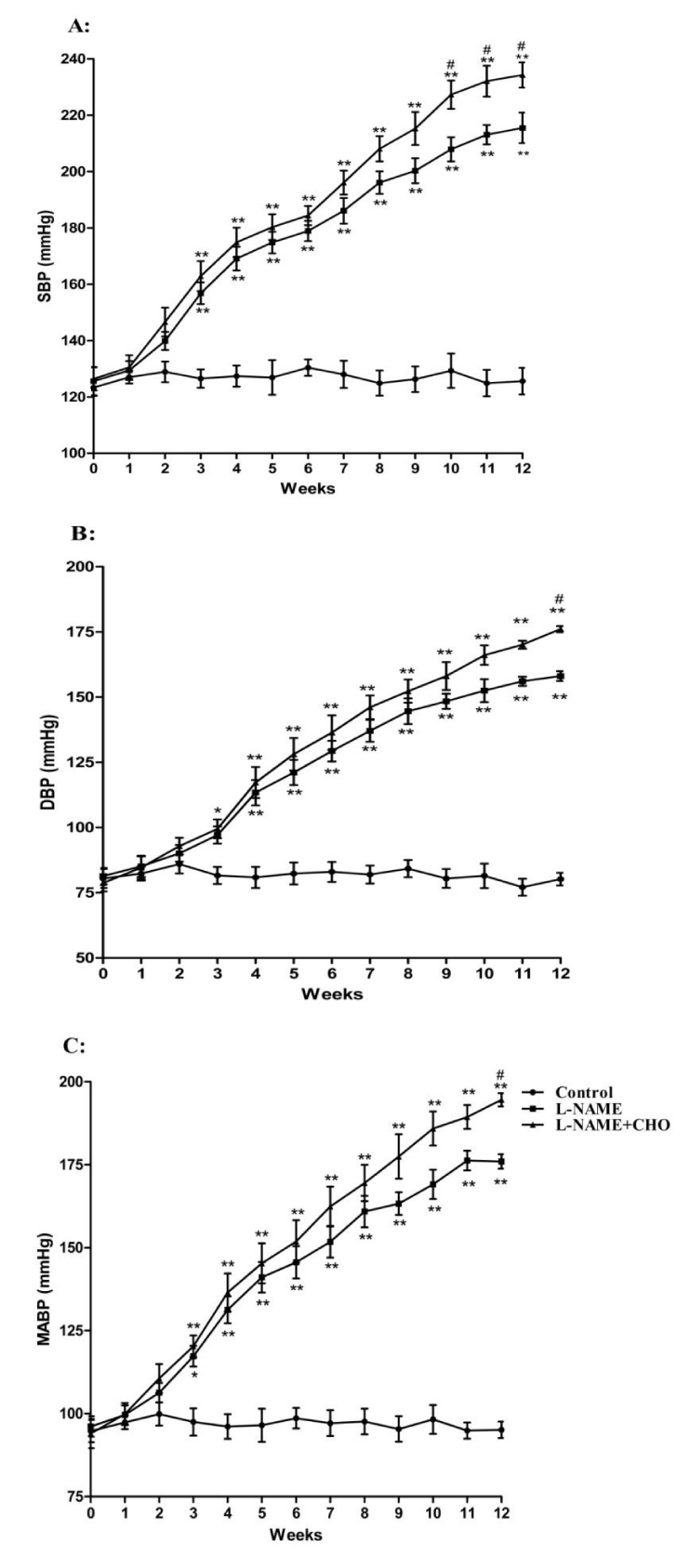
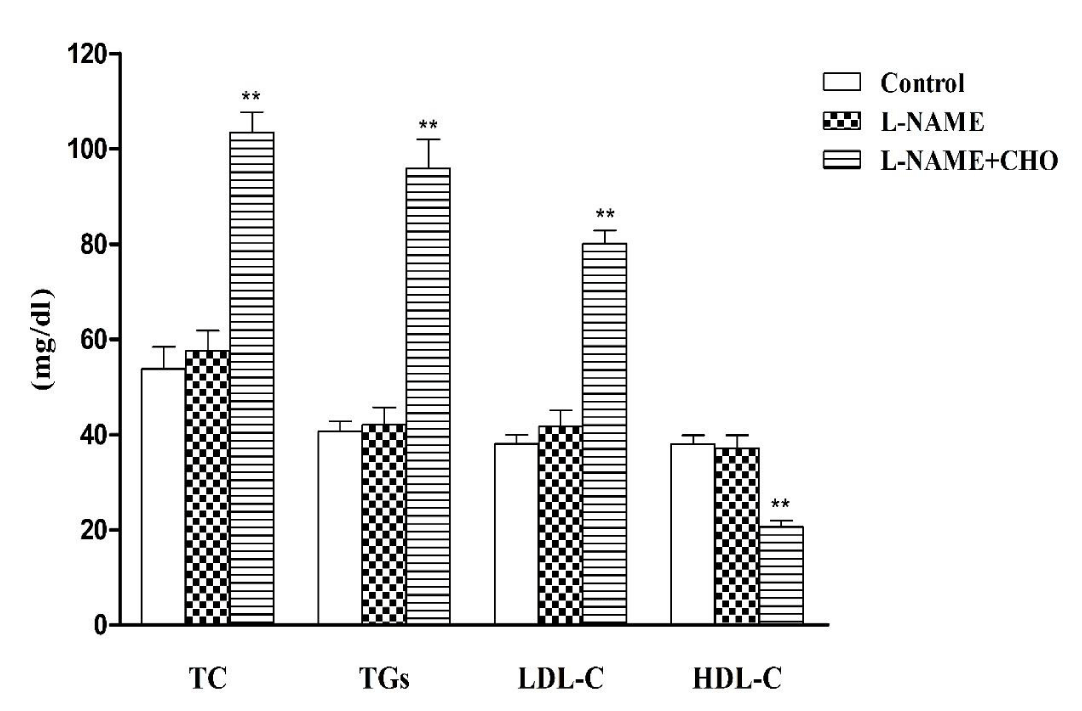
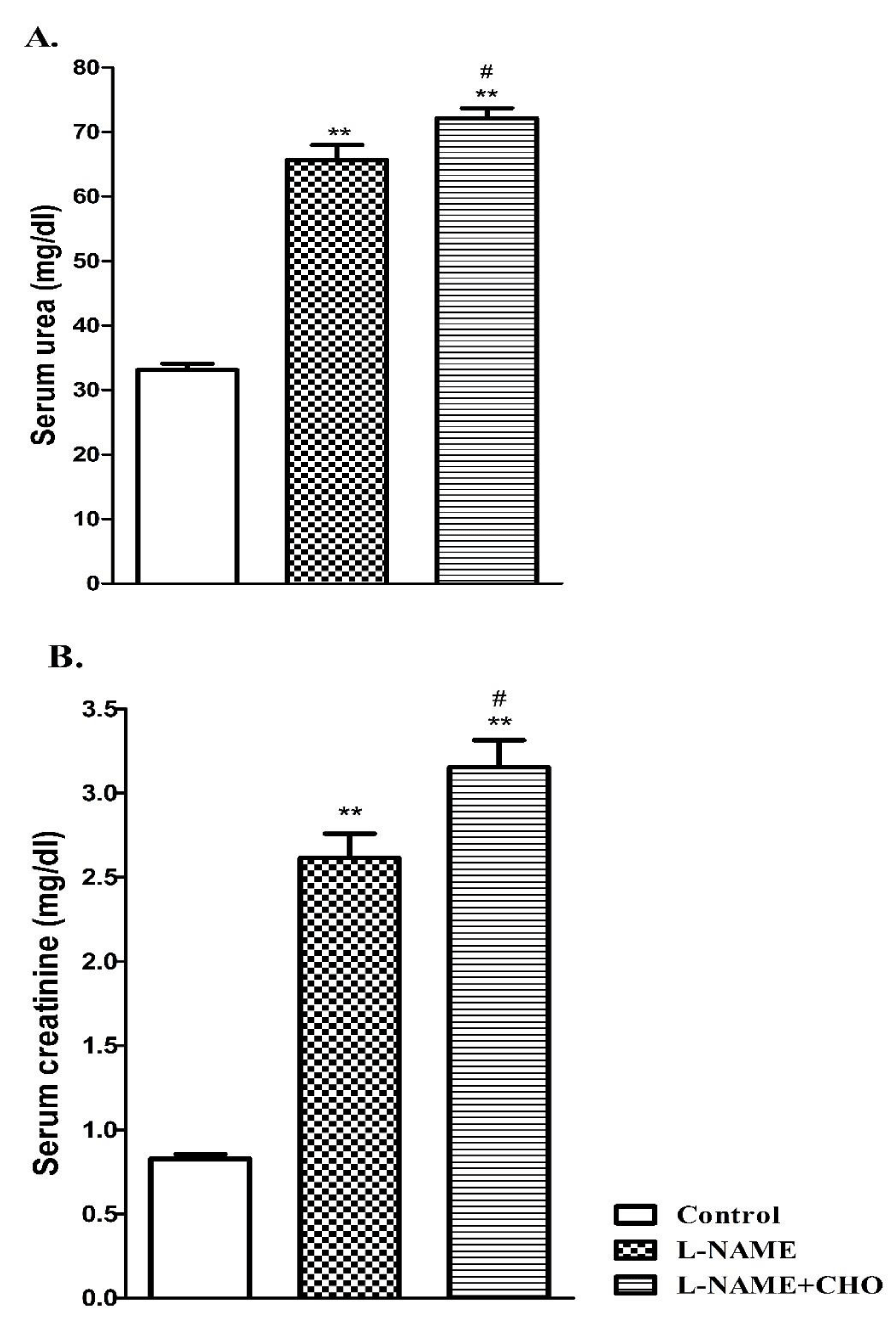
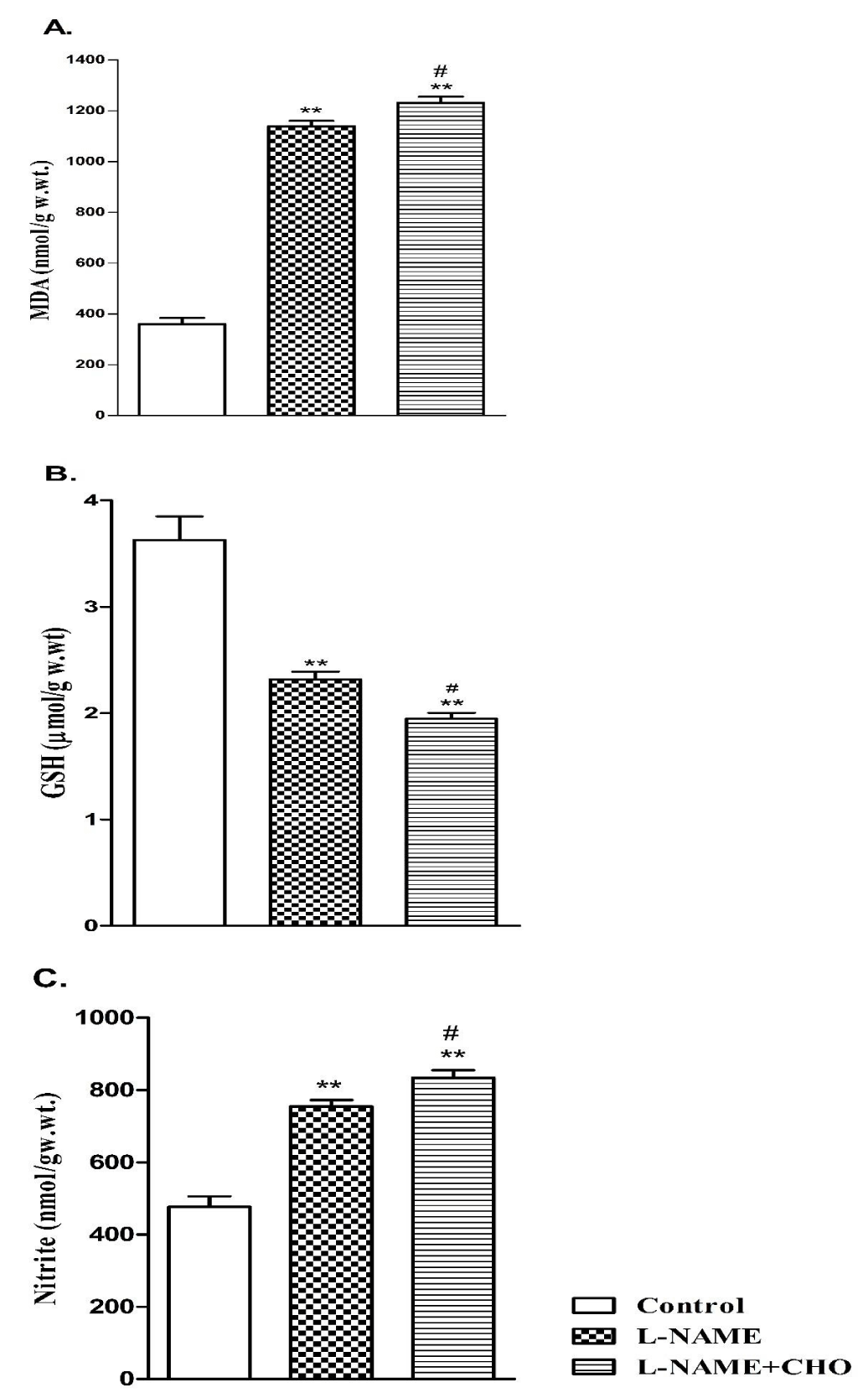
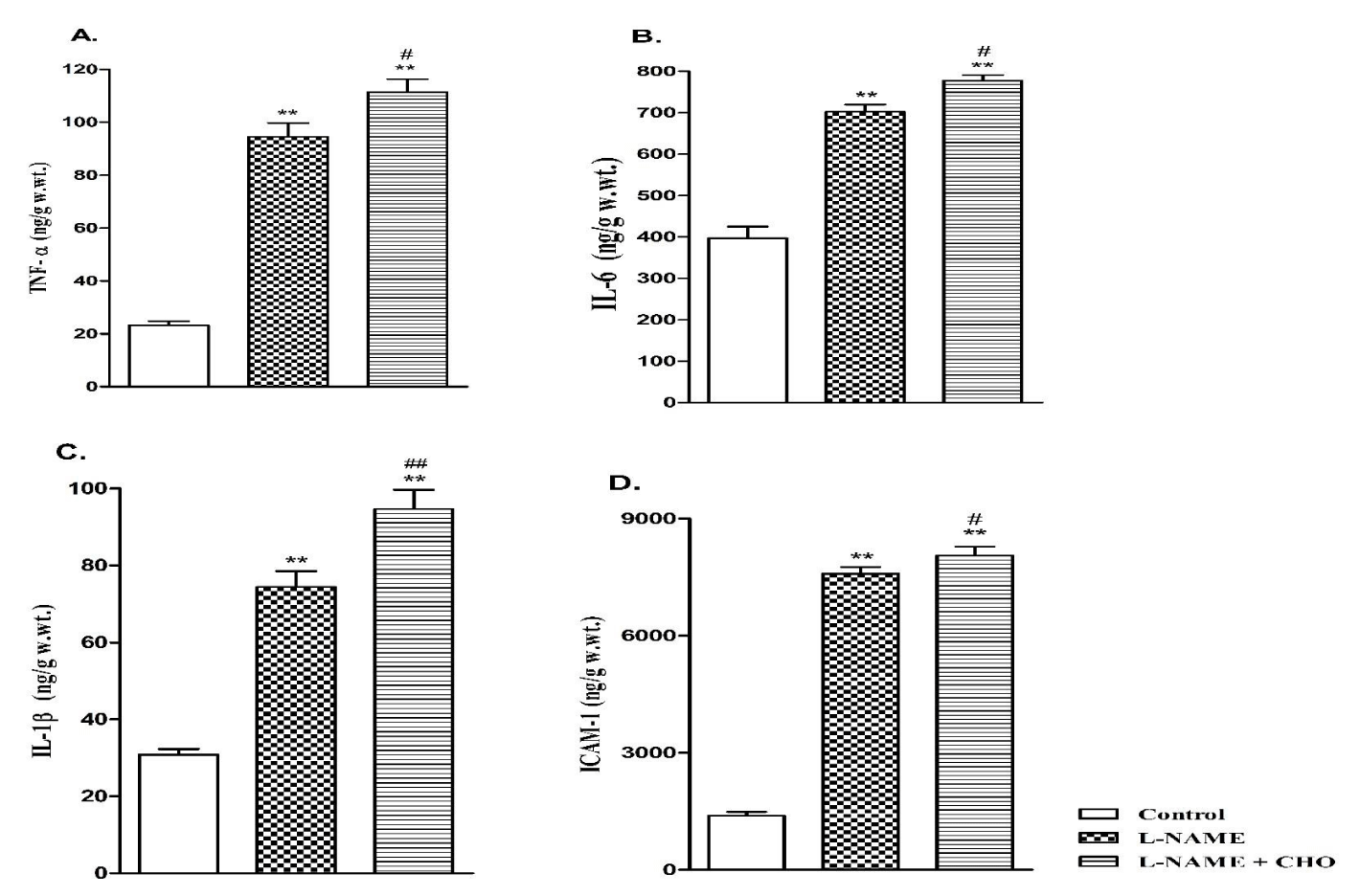
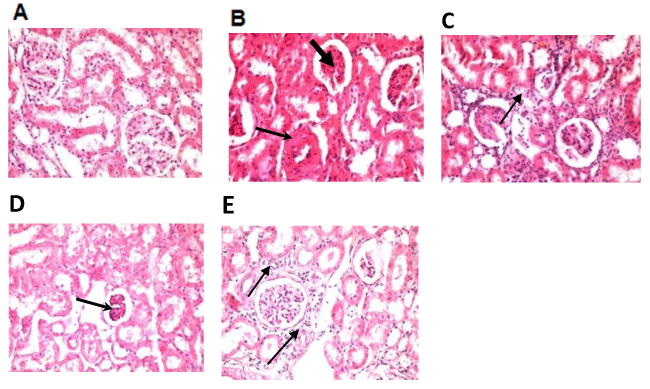
 Save to Mendeley
Save to Mendeley
